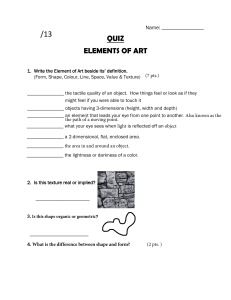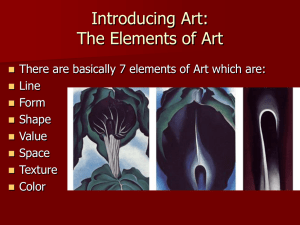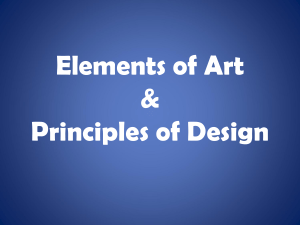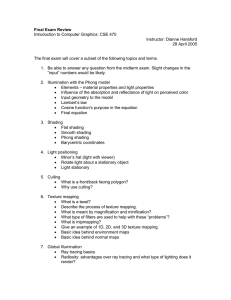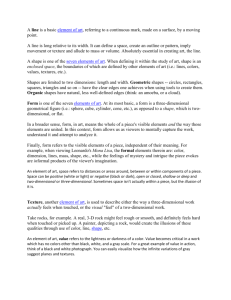Introducing Art: The Elements of Art
advertisement
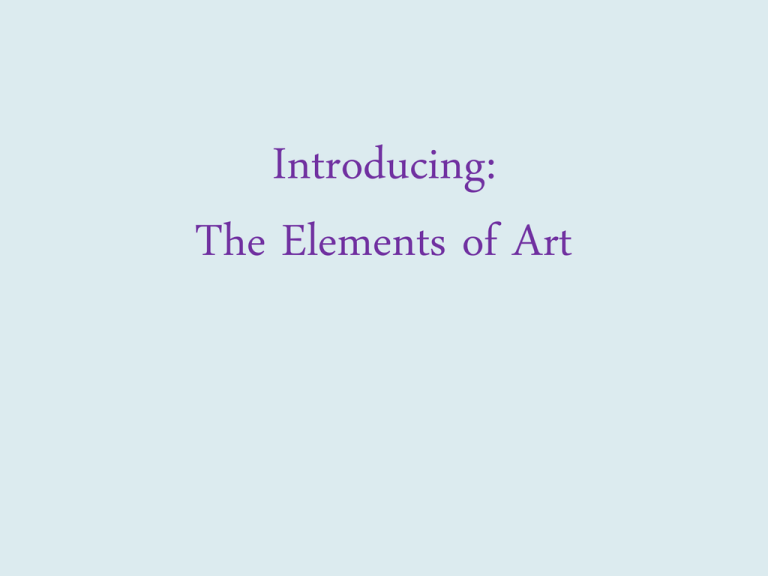
Introducing: The Elements of Art There are basically 7 elements of Art which are: • • • • • • • Line Shape Form Space Value Texture Color Everything has elements. • The elements of art are sort of like atoms, in that both serve as "building blocks". Atoms combine and form other things. Sometimes they'll make a simple molecule, as when hydrogen and oxygen form water (H2O). Or they might form something more complex, like a molecule of sucrose (sugar) (C12H22O11). • A similar activity happens when the elements of art are combined. Instead of hydrogen, oxygen, carbon, etc., in art you've got line, shape, form, space, value, texture and color. Artists manipulate these elements, mix them in with principles of design and compose a piece of art. Not every work has every last one of these elements contained within it, but there are always at least two present. • Art would be sunk without line, sometimes known as "a moving point". While line isn't something found in nature, it is absolutely essential, as a concept, to depicting objects and symbols, and defining shapes. • Shape is formed whenever lines meet or implied by value or color change. • A sculptor, by default, has to have both form and space in a sculpture, because these elements are threedimensional. (They can also be implied in two-dimensional works through the use of perspective and value (or shading). • Value is one of the most powerful tools for the artist because it helps to create many of the other elements, like form, space, texture, line and even color has value (lightness and darkness). Value also enhances most of the Principles like emphasis, balance, contrast. Without it, art would be of no value. (pun intended.) • Texture is another element, like form or space, that can be real or created (think of van Gogh's lumpy, impasto canvases) or implied (through clever use of shading). • Color is the most expressive of the elements and can also be very tricky to use properly. WHY ARE THE ELEMENTS OF ART IMPORTANT? • The elements of art are important for several reasons. First, and most importantly, a person can't create art without utilizing at least a few of them. (No elements, no art, end of story. And we wouldn't even be talking about any of this, would we?) • Secondly, knowing what the elements of art are enables us to (1) describe what an artist has done, (2) analyze what is going on in a particular piece and (3) communicate our thoughts and findings using a common language. • Third, and most importantly, when there is a problem in an art piece it is usually because there is a problem with one of the elements. Going through each element can help us see weak, ineffective, etc. aspects we can fix. Okay, let’s “recap”! Line: • Line is the path of a moving point. Lines define the edges of shapes and forms. "Trio" by Steve Magada, 1966, Oil, Location unknown Shape: height + width = shape • Shape is an area enclosed by line or implied line. It is 2 dimensional and can be geometric or organic. Shape Form Form: Height + width + depth = form • Forms are 3-Dimensional. They occupy space or give the illusion that they occupy the space. Space: • Space is occupying a 3dimensional area or the illusion of objects having depth on a 2dimensional surface. • Value is the lightness or darkness of a surface. It is often referred to as shading but value is also important in the study of color. Value (Lightness and darkness) Texture: • Texture is the actual surface feel of an area or the simulated appearance of roughness, smoothness etc. • Color is the most expressive element of art and is seen by the way light reflects off a surface. Color
